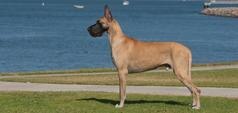
Canine Osteoarthritis: Early Diagnosis & Treatment

Each year, a significant number of dogs experience the discomfort of osteoarthritis (OA). This condition primarily affects obese dogs, as well as large- and giant-breed dogs in their middle to senior years. However, dogs with congenital conditions impacting their hips, elbows, and shoulders, or those with orthopedic injuries such as ligament tears and repetitive stress, face the highest risk.
The term "bone-on-bone" accurately depicts the advanced stage of progressive joint disease. As osteoarthritis (OA) worsens, dogs experience a grinding sensation and chronic pain. This is evident when they struggle to rise, walk with noticeable stiffness, show reluctance to engage in running and playing, or exhibit signs of discomfort when touched in sensitive, inflamed areas.
The objective of treating dogs with osteoarthritis (OA) is to impede the progressive deterioration of cartilage, which acts as a cushion and safeguards the joint bones. Cartilage enables smooth movement within the joint's complete range of motion. Known as degenerative joint disease, OA can reach a debilitating stage where euthanasia may be considered for dogs whose quality of life is significantly compromised.
“The idea is to catch OA before it becomes severe and to try and stop its progression,” says Joseph J. Wakshlag, DVM, PhD, DACVN, DACVSMR, professor of clinical nutrition and veterinary sports medicine and rehabilitation at Cornell University. “For starters, when a dog is overweight, we work on losing weight with the goal of attaining ideal body condition. Carrying excess weight on damaged joints is not only painful for the dog, but it can speed up the process of cartilage degeneration. We also encourage feeding at-risk dogs a diet enriched with long-chain fatty acids, such as omega-3 fatty acids from fish oils, to help slow the progression of OA.”
Potential Treatment
Although there is no cure for OA, veterinarians typically prescribe a nonsteroidal anti-inflammatory drug (NSAID) to help reduce pain and inflammation, and they may add pain medications as needed. Joint supplements with glucosamine and chondroitin may be advised to maintain cartilage integrity, promote healing and increase water retention in the cartilage to provide more joint cushioning.
Dr. Wakshlag, an investigator in a study assessing the efficacy of cannabidiol (CBD) oil for dogs with osteoarthritis (OA), observed that the dogs in the clinical trial experienced a notable reduction in pain and an increase in activity. These findings suggest that hemp nutraceuticals, such as CBD oil, could potentially be used as a therapeutic option in veterinary medicine to alleviate OA-related pain. For more details, refer to the article "CBD Oil Clinical Trials Net Positive Results in Dogs with Osteoarthritis" on page 6.
“There are few pain medications proven to have efficacy for treating OA,” Dr. Wakshlag says. “Some are used routinely with varying success. There are really few options for dogs that don’t include sedation and injections. This is why CBD oil may offer a viable and widely accepted alternative in the near future.”
Early Diagnosis
Recognizing osteoarthritis in its early stages can be challenging, often leading to the condition becoming severe and disabling. Dogs, being stoic creatures, frequently conceal their pain, further complicating early detection. This was the unfortunate scenario when a stunning Akita named "Anna" was diagnosed with severe hip dysplasia.
Recognizing osteoarthritis in its early stages can be challenging, often leading to the condition becoming severe and disabling. Dogs, being stoic creatures, frequently conceal their pain, further complicating early detection. This was the unfortunate scenario when a stunning Akita named "Anna" was diagnosed with severe hip dysplasia.
During Anna's health certification, radiographs revealed severe hip dysplasia, despite no prior indications of the polygenic disease. Hip dysplasia is a developmental condition where the ball and socket of the hip joint do not properly fit together. Hips are typically rated as excellent, good, or fair in normal cases, but ratings of borderline, mild, moderate, or severe indicate a failure to pass the certification.
“Anna was quite muscular, and her body just seemed to mask the dysplasia by holding everything in place,” Dr. Milton says. “I was told that she would likely be crippled at age 4. She never went down, though at the end of her life, she moved slower and did not run as much. She never acted like she was in pain, yet I am sure she had osteoarthritis. She died at age 13.”
Anna’s veterinarian, Treyton “Jai” Diggs, DVM, of All Star Animal Clinic in New Orleans, says, “We managed Anna’s dysplasia with the hope of delaying the onset of severe, painful osteoarthritis. Anna did well on a joint supplement and a diet rich in omega-3 fatty acids, and her owner gave her salmon oil.”
Dr. Diggs advises owners of dog breeds prone to developing osteoarthritis (OA), or those who suspect their dog may have OA, to promptly have joint radiographs taken. “Radiographs of the affected joints allow your veterinarian to rule out other conditions with similar signs. It also provides information about the degree of damage to the joint. A full physical examination that includes palpating the dog’s joints and assessing range of motion is important as well,” he says.
At his veterinary practice, Dr. Diggs frequently examines working dogs, hunting dogs, and large and giant breeds with OA due to wear and tear of their joints. Not all patients are older dogs. “I recently performed shoulder surgery for osteochondritis dissecans in a 10-month-old Labrador Retriever puppy,” he says. “This is typically a breed-predisposed inflammatory condition where diseased cartilage separates from the underlying bone, thus leaving a denuded region of bone that is painful.”
The puppy is likely to be a future OA patient. “Over the dog’s lifetime, we will manage the condition with a joint supplement, a nonsteroidal anti-inflammatory drug and pain medications as needed,” Dr. Diggs says.
“The first sign owners usually notice in affected dogs is irritability due to the pain and inflammation in the joint,” adds Dr. Diggs. “Dogs that sustain injuries from sports typically bounce back faster if they are fed a nutritious, high-quality dog food containing omega-3 fatty acids that nourish the joints.”
Keeping dogs active and managing ideal body condition are essential. “The effects of obesity have much to do with the severity of disease,” Dr. Diggs says. “Lifestyle decisions related to nutrition and activity can be game-changers for at-risk dogs and dogs diagnosed with OA.”
Purina® Pro Plan® is the #1 brand most fed and recommended brand by dog breeders in Canada.* Learn more about the what the Pro Club Breeder program has to offer, including up to 25% savings on Pro Plan dog and puppy food, a free bag of puppy food for your new pet owners and more!
*Canadian Dog Fancier survey results, November 2023
Related articles


